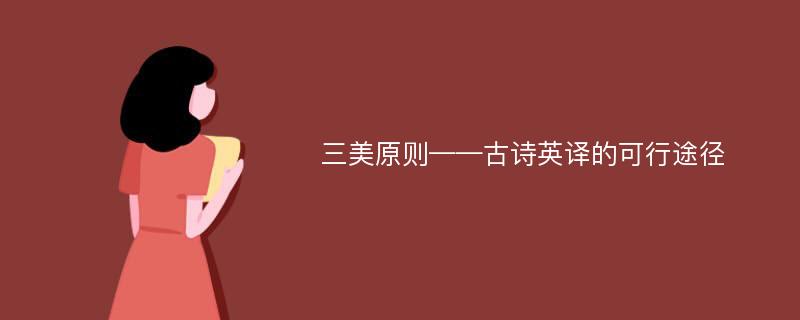
论文摘要
中国古典诗歌是中华文化中的一颗明珠,以其优美的意境和韵律而著称。为了使更多的人能够欣赏到这一文化瑰宝,不少中外学者长期以来一直致力于中国古典诗歌的翻译,把这一不朽的文化遗产介绍给世界。然而,汉语和英语属于不同的语系,且中国和英语国家有着不同的历史文化、社会习俗以及语言背景,因此中国古典诗歌的翻译是一项极其艰巨的任务。不同的译者在译诗时有着不同的翻译策略,因而形成了不同的译诗流派。在我国,中诗英译的流派主要可以分为三大派:格律诗体派、自由诗体派以及仿译派。格律诗体派的核心主张是以诗译诗。而自由诗体派则主张放弃韵脚,不拘泥于行数限制,但保持一定的节奏,追求最大的限度地传达原诗的意义。仿译派则认为译诗在于保持原诗本色,不必模仿其形式。三大流派各有所长又各有其缺陷。由于各大流派之间的分歧难以折中,我们不妨从另一个角度来探讨诗歌翻译。既然美是诗歌的重要特性,诗歌翻译可以视为一个传递原诗美的过程,我们不妨借用美学的观点来探讨诗歌翻译。许渊冲教授结合我国传统译论及自身丰富的诗歌翻译实践,提出了诗歌翻译的“三美”原则——“意美”、“音美”和“形美”。“意美”即传递原诗的神韵;“音美”指译诗押韵,也就是诗歌要有节奏、押韵、顺口、好听;“形美”指译诗诗行整齐或长短不齐如原诗。由于三美理论强调美,尤其是音美,因此与以信为本的传统翻译理论有了冲突,译界对三美理论有着不同看法,褒扬者有之,反对者亦不少。本文主要探讨了三美原则用于诗歌翻译的可行性。作者先从英汉诗歌的对比研究出发,讨论了汉诗英译的难点和要求以及各流派的不同观点,并提出从美学角度来探讨诗歌翻译。作者接着介绍了三美原则的来源、内容以及方法论,同时用具体实例分析了三美原则在再现原诗意美、音美和形美方面的可行性,并分析了读者对三美原则指导下的译文的反应。作者最后指出了三美原则的某些不足之处。本文作者通过分析三美原则在中国古典诗歌中的运用,并结合许渊冲的翻译实践,得出以下结论:三美原则用于中国古典诗歌翻译有其可行性,但也有其不足,应辨证地对待,进行合理的运用。
论文目录
相关论文文献
- [1].The Mood Translation of Chinese Poetry under Cross Cultural Communication[J]. 海外英语 2017(11)
- [2].主题应用·语库构建[J]. 疯狂英语(新阅版) 2020(04)
- [3].Ancient Poetry Shines[J]. Beijing Review 2020(26)
- [4].Domestication of Taoism in Bly's Ancient Chinese Poetry of Translation[J]. 读与写(教育教学刊) 2017(01)
- [5].Love of Chinese Language Expressed in Couplets[J]. China Today 2016(12)
- [6].Poetry Revival[J]. Beijing Review 2017(08)
- [7].Foreignization of Taoism in Robert Bly's Poetry[J]. 校园英语 2016(35)
- [8].The comparison of language of Chinese and English love poetry[J]. 校园英语 2016(36)
- [9].Images in Classical Chinese Poetry——View on Life of Pi[J]. 校园英语 2017(03)
- [10].井上有一作品[J]. 诗书画 2017(01)
- [11].Plato and The Book of Poetry:The Paradoxical Relationship between the Classic and Creativity[J]. Comparative Literature:East & West 2016(02)
- [12].Appreciation of Sonnet 18[J]. 校园英语 2017(20)
- [13].九个妖作品[J]. 青春 2017(09)
- [14].Thoughts on the language of the New Chinese Poetry[J]. 山海经 2015(06)
- [15].Poetry Poems[J]. 明日风尚 2011(02)
- [16].Poetry Poems[J]. 明日风尚 2011(03)
- [17].A Dialogue between Chinese and American Poets in the New Century:Their Poetry Reading,Translation and Writing in Collaboration[J]. Comparative Literature:East & West 2011(02)
- [18].Coleridge and Romantic Poetry[J]. 海外英语 2017(04)
- [19].Approaches to Basic Concepts in English Translation of Classical Chinese Poetry[J]. Comparative Literature:East & West 2009(01)
- [20].English Metaphysical Ideas Reflected in Anne Bradstreet's poetry[J]. 海外英语 2013(06)
- [21].The 2nd Convention of Chinese/American Association for Poetry and Poetics & International Symposium on Literatures in English(June 15-16,2013)[J]. 外国文学研究 2012(04)
- [22].Research on the Poetry[J]. 海外英语 2011(03)
- [23].The Defects in Translating Tang Poetry into English[J]. 海外英语 2010(08)
- [24].A Brief Analysis on the Symbolism of Yeats' s The Second Coming[J]. 校园英语 2016(10)
- [25].Compare Horace's Art of Poetry and Nicolas Boileau-Despreaux's The Art of Poetry[J]. 大众文艺 2010(07)
- [26].A Deconstructive Approach to Translation Strategies of Visual Poetry[J]. 海外英语 2019(24)
- [27].Study on the Emotions Conveyed by the Moon Image in Classical Poetry[J]. 海外英语 2020(09)
- [28].The 5th CAAP Convention of The Chinese/American Association for Poetry and Poetics(Los Angeles,USA/November 11-14,2016)[J]. 外国文学研究 2016(02)
- [29].The ancient Chinese poetry[J]. 魅力中国 2009(32)
- [30].Translation Ecology Analysis of The Book of Songs & Book of Poetry[J]. 海外英语 2013(03)
